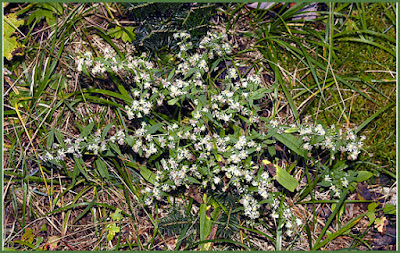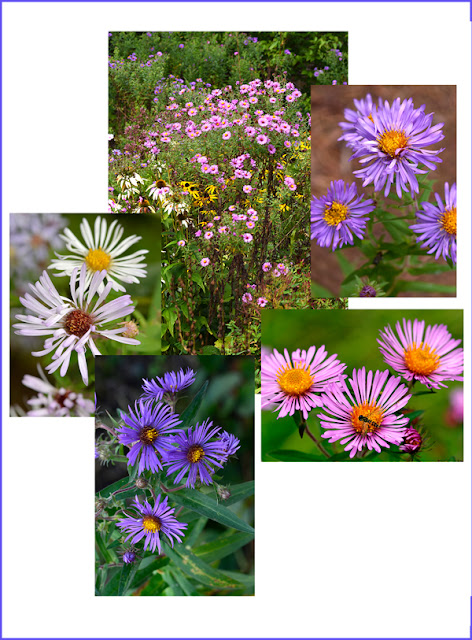Asters can be very difficult to identify. Several species have very close cousins which look much alike, making them hard to tell apart, and in all cases growing conditions can really affect how a plant looks. Several species can vary from only a couple of inches tall in bad situations to several feet tall in good situations. Flowers can be very variable in colour and size. And to make it even more of a challenge, Asters are notorious for crossing and back-crossing. Hybrids are quite common, often the results of our native Asters crossing with non-native garden Asters.
 Let's start with possibly the least common, at least in gardens, Calico Aster or Symphyotrichum lateriflorum. This is one of the earliest to bloom, often showing up in wild places in early July. It isn't very tall, usually less than 18", and the flowers, while numerous, aren't impressive. What is fun about them, though, is that the centres, which in the Compositae are the actual flowers (disc flowers as opposed to the merely decorative ray flowers), start yellow and fade to reddish mauve and then brown. All three colours are on the plant at the same time, giving it a motley appearance and its name, Calico Aster. Calico is easy to cultivate. It develops rosettes at ground level in the fall, which are easily uprooted and moved. It doesn't spread particularly, although it sometimes seeds around. It likes dry sunny situations.
Let's start with possibly the least common, at least in gardens, Calico Aster or Symphyotrichum lateriflorum. This is one of the earliest to bloom, often showing up in wild places in early July. It isn't very tall, usually less than 18", and the flowers, while numerous, aren't impressive. What is fun about them, though, is that the centres, which in the Compositae are the actual flowers (disc flowers as opposed to the merely decorative ray flowers), start yellow and fade to reddish mauve and then brown. All three colours are on the plant at the same time, giving it a motley appearance and its name, Calico Aster. Calico is easy to cultivate. It develops rosettes at ground level in the fall, which are easily uprooted and moved. It doesn't spread particularly, although it sometimes seeds around. It likes dry sunny situations.Slightly, but only slightly, more common in gardens is Large-leaved Aster, Eurybia macrophylla. When it does occur in a garden, it is either a woodland garden or the gardener has some sort of ulterior motive. It spreads a lot and takes serious managing. In the wild it is found in open spots under trees or along verges. It can form large carpets of its dry raspy leaves.
Usually, only a few plants in a patch will put up flower stalks, although this varies according to the clone and the growing conditions. In the woods you might see a patch 50' across with only 5 or 6 stalks. A couple of years ago I happened to be in a campground in Algonquin Park and I was surprised to see a large patch with many flower stalks and nicely mauve flowers. The flowers are more usually white. I later got some seeds and now I have a small patch growing along my fence row which this year produced one stalk of mauve flowers.
Large-leaved Aster spreads by stolons which are right at or just below the surface. You can restrain it by removing these, but be warned, they put out new ones all summer long. No keeping this one down!
Another uncommon one is Heath Aster, Eurybia ericoides. Its name comes from the many many small leaves (reminiscent of heather) all along the stems and in among the flowers. Not that it is easy to find them once the flowers open because Heath Aster in bloom is a cloud of white. It is about 2 to 3' tall, bushy and sturdy. Once established, it will be covered in white froth from early September to October. Definitely a late bloomer, but so welcome in the fall border. It spreads like all Asters, but is easily enough controlled. In too-dry situations it is apt to mildew although that never seems to affect the blooming and you won't see it anyway.
The description of Heath Aster in the field guides makes it hard to identify, but once you have seen a plant you won't have any more trouble with it. Its overall appearance is very distinctive.
Lance-leaved Aster, Symphyotrichum lanceolatum, sounds very similar in the books, but is quite different in the field. It is taller than Heath Aster, going up to a good 3', spreads to form a patch rather than a large clump, and blooms quite a bit earlier. The stem leaves are long and narrow, hence the name.
S. lanceolatum is useful in the wild garden. It fills its space, mingles with whatever is around it, and looks healthy all summer long. You can keep it in its assigned space by pulling the stems you don't want, they come right up and you can either start more patches or add to your compost collection. It likes a fair amount of sun but isn't fussy.
Different clones of this one can have slightly different appearances, some taller, some shorter, the occasional one pale pink or pale mauve, some stems soft and 'bendy' and others very stiff and straight.
Now let's look at a pair of Asters, one of which is very common here, and the other which is more common than you might think.
Heart-leaved Aster, Symphyotrichum cordifolium, is probably the Aster you will see the most of if you hike in the woods in the Ottawa area. It starts blooming early and continues late. The heart-shaped leaves in rosettes pressed to the ground are everywhere it can find some sun, openings in the woods, along driveways, roads, fields, even our gardens. You have probably pulled it as a weed!
In the pictures above, note the heart-shaped leaf partway up the flowering stem. Only the leaves right at the flower branches are oval, all the others are clearly heart-shaped.
It us usually a soft blue-mauve, but can be white and occasionally, pale pink. It mixes well in the border, and like all the Asters, is much appreciated by the bees and wasps. A large plant can be filled with happy buzzing from several species of bees.
Close in appearance, but a different species, is Symphyotrichum ciliolatum, Lindley's Aster or Fringed Blue Aster. At first glance you might think it a slightly bluer, slightly 'looser', slightly more spreading Heart-leaved Aster, but look again.
The leaves partway up the stems are pointed oval, not heart-shaped, and have winged stalks. Leaves near the ground, while still clearly oval, will not have the 'wings'. S. ciliolatum gets a bit taller than S. cordifolium, maybe 3' to its 2 1/2', and the flowers are held farther apart, giving an airier and more graceful effect. In the garden it behaves exactly the same as its cousin.
Last, but absolutely not least, this is New England Aster, Symphyotrichum novae-angliae. Yousee it, lots of it, every fall, in every old field and neglected edge in the Valley.
Easy to grow, a nice 'presence' in the wild garden or even the traditional border, and you can find a number of colour forms for sale in the nurseries. Some of the varieties sold in the nurseries were developed in Germany, which means that they may not bloom here until very late in the season. The only one of these that I have is called 'Andenken an Alma Potsche' which mouthful I usually shorten in my mind to 'Alma'. She is an unusual deep coral red. Not an easy colour to mix into a garden, and she blooms so late there is little to accompany her. If it is chilly enough, Alma is quite red, otherwise she comes out deep coral. The colours shown above all appeared naturally at my place and I am trying to preserve them. The white one in particular is gorgeous. This year it bloomed spectacularly behind a patch of deep pink Turtleheads. It would have been a garden triumph except that I also had a tall white-blooming hosta there and the hosta flowers threw everything off. Next year, somebody is moving.
Another clone I have, which has fine amethyst-coloured flowers, blooms very early. It opens its first blooms in July, and continues through until well into September. It too will have to move next spring as it is at the very edge of the garden and keeps getting stepped on, but it is definitely a keeper.
So, some of our native asters. There are more, but they are fairly rare and some of them are not very impressive, garden-wise. All are beloved by the pollinators, all help give a garden a sense of 'place', all are excellent plants for slightly back in the border, and all bloom late when you really need them. Asters, frustrating but wonderful!

















